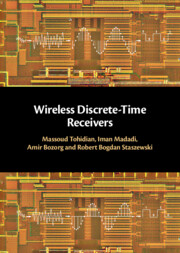2 - First Stage: Low-Noise Transconductance Amplifier
Published online by Cambridge University Press: 05 May 2022
Summary
To be able to amplify an RF signal located at any of the supported cellular frequency bands, a wideband noise-canceling low-noiseamplifier (LNA) appears to be a good choice. As the receivers, later introduced in Chapter 5, are based on sampling the input charge, the RF amplifier needs to provide current rather than voltage, thus acting as a transconductance amplifier (TA) exhibiting a high output impedance compared to the input load of its subsequent stage. An LNTA (i.e., LNA+TA) could trivially be constructed by cascading LNA and TA (gm) stages. However, to improve noise and linearity, both of these circuits should be codesigned and tightly coupled. This chapter presents examples of state-of-the-art wideband noise-canceling LNTAs.
Keywords
Information
- Type
- Chapter
- Information
- Wireless Discrete-Time Receivers , pp. 23 - 54Publisher: Cambridge University PressPrint publication year: 2022
